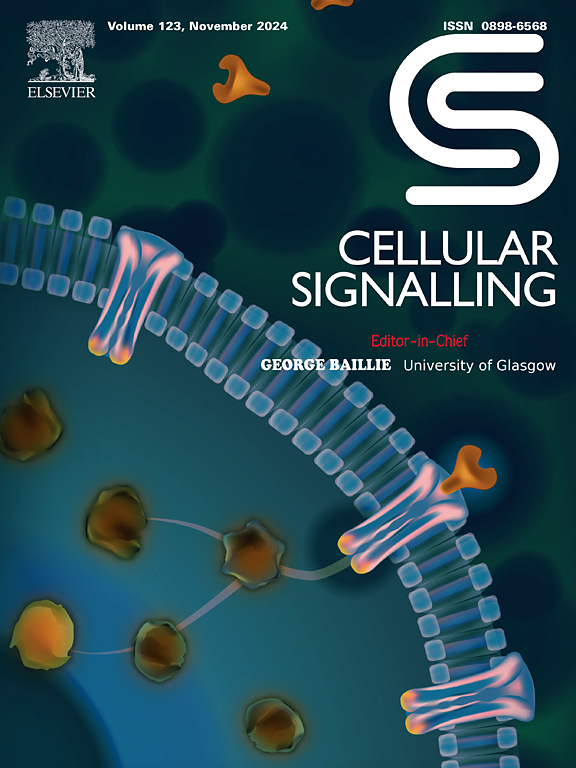RORα通过akr1a1诱导的葡萄糖和脂质重编程抑制胃癌细胞增殖和化疗耐药。
IF 4.4
2区 生物学
Q2 CELL BIOLOGY
引用次数: 0
摘要
背景:糖酵解和脂质代谢异常在胃癌的发生发展中起重要作用。此外,昼夜节律基因的失调与肿瘤微环境中的代谢重编程有关。本研究旨在确定维甲酸相关孤儿受体α (RORα)在GC中葡萄糖和脂质重编程中的作用。方法:采用功能增益和功能丧失实验研究其对体外和体内细胞增殖和耐药的影响。糖酵解活性和脂质合成使用海马试验和试剂盒进行评估。此外,利用GC细胞的半衰期、共免疫沉淀(Co-IP)、染色质免疫沉淀(ChIP)、荧光素酶报告基因和免疫荧光共定位等方法探讨了调控机制。此外,通过公共数据库和回顾性临床病理分析,分析了rora与E47和AKR1A1的关系。结果:RORα缺失通过增加糖酵解活性和脂质合成,促进细胞增殖和氟尿嘧啶(5-FU)化疗耐药。相比之下,rora激活剂SR1078逆转了这些变化,并与2-脱氧葡萄糖(2-DG)或阿托伐他汀联合对细胞增殖具有协同抑制作用。从机制上讲,醛酮还原酶家族1成员A1 (AKR1A1)是ror α介导的葡萄糖和脂质重编程的关键驱动因素。具体来说,E47是一种AKR1A1转录因子,其稳定性受到β-catenin的影响。rora缺失通过上调β-catenin间接促进E47蛋白的稳定性,导致AKR1A1转录活性增加。此外,胃癌患者的rora、E47和AKR1A1表达异常,并与临床病理参数和预后相关。这些表达模式包括ror α-低、e47 -高和akr1a1 -高表达模式单独或联合与反应性降低、预后不良、标准摄取值(SUV)水平升高和脂滴形成相关。结论:这些发现揭示了RORα调节葡萄糖和脂质重编程的新机制,可能是GC治疗的有希望的靶点。本文章由计算机程序翻译,如有差异,请以英文原文为准。
RORα inhibits proliferation and chemoresistance through AKR1A1-induced glucose and lipid reprogramming in gastric cancer
Background
Abnormal glycolysis and lipid metabolism play important roles in the occurrence and development of gastric cancer (GC). Moreover, dysregulation of circadian genes is associated with metabolic reprogramming in the tumor microenvironment. This study aimed to determine the role of retinoic acid-related orphan receptor alpha (RORα) in glucose and lipid reprogramming in GC.
Methods
The effects on cell proliferation and chemoresistance in vitro and in vivo were studied using gain- and loss-of-function experiments. Glycolytic activity and lipid synthesis were assessed using a Seahorse assay and reagent kits. Moreover, the regulatory mechanisms were explored using half-life, coimmunoprecipitation (Co-IP), chromatin immunoprecipitation (ChIP), luciferase reporter and immunofluorescence colocalization assays in GC cells. In addition, the relationships of RORα with E47 and AKR1A1 were analyzed using public databases and retrospective clinicopathological analyses.
Results
RORα deletion promoted cell proliferation and fluorouracil (5-FU) chemoresistance by increasing glycolytic activity and lipid synthesis. In contrast, SR1078, an RORα activator, reversed these changes and had a synergistic inhibitory effect on cell proliferation in combination with 2-deoxygulose glucose (2-DG) or atorvastatin. Mechanistically, aldo-keto reductase family 1 member A1 (AKR1A1), is the key driver of RORα-mediated glucose and lipid reprogramming. Specifically, E47 is an AKR1A1 transcription factor, and its stability is affected by β-catenin. RORα deletion indirectly promoted E47 protein stability through the up-regulation of β-catenin, leading to increased AKR1A1 transcriptional activity. Moreover, RORα, E47 and AKR1A1 expression was dysregulated, and associated with clinicopathological parameters and prognosis in patients with GC. These expression patterns including RORα-low, E47-high and AKR1A1-high expression patterns alone or in combination were correlated with reduced responsiveness, poor prognosis, increased standard uptake value (SUV) levels and lipid droplet formation.
Conclusions
These findings reveal a novel mechanism by which RORα regulates glucose and lipid reprogramming and may be a promising target for GC treatment.
求助全文
通过发布文献求助,成功后即可免费获取论文全文。
去求助
来源期刊

Cellular signalling
生物-细胞生物学
CiteScore
8.40
自引率
0.00%
发文量
250
审稿时长
27 days
期刊介绍:
Cellular Signalling publishes original research describing fundamental and clinical findings on the mechanisms, actions and structural components of cellular signalling systems in vitro and in vivo.
Cellular Signalling aims at full length research papers defining signalling systems ranging from microorganisms to cells, tissues and higher organisms.
 求助内容:
求助内容: 应助结果提醒方式:
应助结果提醒方式:


